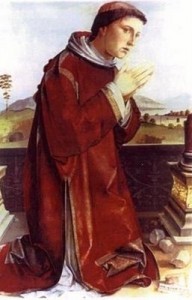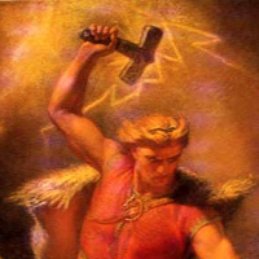St. Reinold-A Murder and Three Mysteries
The January edition of the Magnificat included the story of St. Reinold, religious and marytr (980 c.) He died at the hands of stone masons and later came to be venerated as their patron saint. 
There are various versions of his life and martyrdom. St. Reinhold may have been a monk, a knight, a pilgrim–or all three. He may be a fabrication of several different people, stories and legends. Even his murder may have several explanations.
Version I: Reinold was a Benedictine monk of the monastery of Saint Pantaleon in Cologne, Germany. He was entrusted with the duty of overseeing the construction work to complete the abbey.
Reinold was murdered by the stone masons working on the building. They beat him to death with their hammers and threw his body into a pool of water near the Rhine river.
In one telling, Reinold is killed due to his “over-strenuous diligence,” which incurred the hostility and bitter resentment of the stone masons. In a second account, he was murdered by stone masons who were annoyed that Reinold worked harder and with more skill then they did.
Reinold’s fellow monks were unable to find his body until its whereabouts were made known in a private revelation to an infirm poor woman. His body was taken to the abbey and buried with honor.
Version II: St. Reinold was drawn from the story of Renaud, the youngest son of Duke Aymon of France. He was supposedly a descendant of the sister of Charlemagne, and the 4th son mentioned in William Caxton’s romantic poem, Romance of the Foure Sonnes of Aymon.
The four sons of Duke Aymon are Renaud, Richard, Alard and Guiscard, and their cousin is the sorcerer, Maugis. Maugis was raised by the enchantress Oriande la Fee. He won the magical horse Bayard–who could understand human speech–and the sword Froberge which he later gave to Renaud.
The oldest extant version of the story of Renaud de Montauban and his cousin, Magris, was the anonymous Old French chanson de geste Quatre Fils Aymon which dates from the late 12th c.
In the tale, Renaud and his three brothers were sons of Aymon of Dordone. They flee from the court of Charlemagne after Renaud kills another of Charlemagne’s nephews in a brawl over a chess game. Renaud kills the man by battering him with a chess board. A long war follows, during which Renaud and his brothers remain faithful to the Christian chivalric code.
The four brothers are pardoned on the condition Renaud go to the Holy Land on crusade (or on a pilgrimage), and their magical horse Bayard, who could expand his size to carry all four brothers, be surrendered to Charlemagne. 
Charlemagne orders Bayard to be drowned by chaining it to a stone and throwing it in the river Meuse, but the horse escapes and lives forever more in the Ardennes forests.
After further adventures soldiering in the Holy Land, Renaud returns home. On his return he abandons his home and gives himself up to religion. He eventually makes his way to Cologne and enters the monastery of St. Pantaleon, where be works as a mason on the Church of St. Peter. He is murdered by jealous fellow masons. His body is miraculously saved from the river and magically makes its way home to his brothers in a cart.
In art, St. Reinold is depicted with armor, reflecting the tradition that he had been a soldier before entering monastic life. He is also shown as a Benedictine monk with a stone mason’s hammer; as a monk being killed by stone masons, and as a dead monk being thrown in water.
Besides his identity, I have three other mysteries to solve: 1) why was he murdered; 2) why was he named a saint; and strangest of all, 3) Why he was named a patron saint of the group of people who killed him?
Here are my two versions:
Story 1: Brother Reinold is two people: pious in prayer and a mean, overbearing, and cruel overseer. Hatred and resentment build up among the stone masons he supervises. He oversteps his bounds one day, striking, kicking or punishing someone he bullies to push them to work harder. The man or his friend strikes back in self defense or in a fury. The others finish the job and try to get rid of the body. A local poor woman knows where the body was disposed, and tells the monks the place came to her in a dream from God. The monks find the body and attribute it to divine revelation. They don’t pursue the killers because they know Reinold was a creep and they need their abbey completed. Over the years, long after all the murderers and monks are dead, Brother Reinhold becomes a patron saint of stone masons because he was associated with them, and his *martyrdom* came at their hands.
Story 2: A former warrior named Renaud shows up at the Monastery of St. Pantaleon in Cologne after soldiering in the Holy Land. They can’t pronounce his French name and it comes out sounding like “Reinold.” He comes from an aristocratic family, a descendant of the legendary Charlemagne, and cousin to a famous sorcerer. He makes sure everybody knows it, and the fact he has given it all up to follow a monastic life. He is tough, skilled and hard, and drives himself and everyone around him with a religious zeal. Newly devout, Renaud hectors the other half-pagan stone masons about their lives and picks fights with them. One day, they turn on him in a group and kill him. The body is never found, although local legend has it returning to France in a magical cart–derived, no doubt, from his stories about his horse, Bayard.
Could there have been a darker meaning behind his death? Some historical evidence points to a Christian-Pagan clash or ritual: according to the book, The Ciphers of the Monks by David A. King, German stone mason’s marks (Steinmetzzeichen) were often based on the runes. They chiseled these marks into the stones, especially the foundation stone, as their signature. I can see how that would fill a zealous Christian with horror and anger–an affront to the consecration of the building.
Two hundred years earlier another Benedictine, St. Boniface, was bludgeoned and hacked to death for insulting the gods. 
Medieval people also used “foundation sacrifices” or burials to ensure the stability of a building–castle, bridge and sometimes, churches. They also had a tradition of sacrificing people to placate the spirits of a place. The sacrificed person, in turn, became its protector. Often these were children, sometimes adults, who were entombed alive within the structure. In other sacrifices a dead person was thrown into a pool of water as a votive offering. Could this been what happened to Reinold?
If a monk-mason named Reinold ever existed, and whatever the reasons were behind his death, ultimately the church profited by his romantic and legendary associations. Over time he became “St. Reinold,” martyred for the faith by fellow stone masons jealous of his example.
In one of those delicious ironies the Catholic Church is so famous for, he becomes their patron saint and protector.
I did notice that mason’s hammers bear a strong resemblance to Mjollnir, the hammer of Thor. Just a coincidence, or a subtle clue to his killers? 
